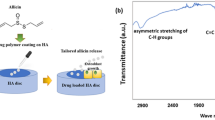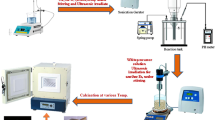Abstract
Hydroxyapatite (HAp) has recently attracted increased interest as a promising material with a wide variety of biomedical applications in orthopedics and dentistry. Meanwhile, bone tissue engineering has not been widely adopted in clinical practice because of the prevalence of postoperative infections. Therefore, enhancing the potential of HAp with antimicrobial agents would be an optional way of preventing bacteria persistence in chronic or long-term infections. Xanthone substance obtained as a mangosteen (MG) extract inhibited a broad spectrum of bacteria that slowed recovery of injury and wounds. Scanning electron microscopy was used to characterize the surface morphology of MG-coated HAp granules, whereas in vitro studies tested the antibacterial susceptibility of bacterial strains usually involved in wound infection. MG-coated HAp granules strongly inhibited bacterial growth with a clear zone after 24 h in time-kill tests. Cytotoxicity was investigated to assess the viability of MC3T3-E1 cells. Results indicated positive mineralization of MC3T3-E1 cells. MG-coated HAp granules were successfully produced and showed potential for bone tissue engineering applications.
Graphic abstract







Similar content being viewed by others
References
Tavafoghi M, Brodusch N, Gauvin R, Cerruti M (2016) Hydroxyapatite formation on graphene oxide modified with amino acids: arginine versus glutamic acid. J R Soc Interface 13(114):20150986
Zapanta LeGeros R, Ito A, Ishikawa K, Sakae T, Legeros J (2010) Fundamentals of hydroxyapatite and related calcium phosphates. Adv Biomater Fundam Process Appl. https://doi.org/10.1002/9780470891315.ch2
Pryor LS, Gage E, Langevin C-J, Herrera F, Breithaupt AD, Gordon CR et al (2009) Review of bone substitutes. Craniomaxillofac Trauma Reconstr 2(3):151–160
Yoshikawa H, Myoui A (2005) Bone tissue engineering with porous hydroxyapatite ceramics. J Artif Organs 8(3):131–136
Hardy P, Kania R, Verliac S, Lortat-Jacob A, Benoit J (1997) Infection following the use of porous hydroxyapatite ceramic as a bone defect filler in articular fractures. Eur J Orthop Surg Traumatol 7(2):63–67
Kolmas J, Groszyk E, Kwiatkowska R (2014) Substituted hydroxyapatites with antibacterial properties. Biomed Res Int 2014:178123
Pandey A, Midha S, Sharma RK, Maurya R, Nigam VK, Ghosh S et al (2018) Antioxidant and antibacterial hydroxyapatite-based biocomposite for orthopedic applications. Mat Sci Eng C 88:13–24
Ohsumi Y, Kitamoto K, Anraku Y (1988) Changes induced in the permeability barrier of the yeast plasma membrane by cupric ion. J Bacteriol 170(6):2676–2682
Stanić V, Dimitrijević S, Antić-Stanković J, Mitrić M, Jokić B, Plećaš IB et al (2010) Synthesis, characterization and antimicrobial activity of copper and zinc-doped hydroxyapatite nanopowders. ApSS 256(20):6083–6089
Ghuman S, Ncube B, Finnie JF, McGaw LJ, Coopoosamy RM, Van Staden J (2016) Antimicrobial activity, phenolic content, and cytotoxicity of medicinal plant extracts used for treating dermatological diseases and wound Healing in KwaZulu-Natal. South Afr Front Pharmacol 7:320
Chen L-G, Yang L-L, Wang C-C (2008) Anti-inflammatory activity of mangostins from Garcinia mangostana. Food Chem Toxicol 46(2):688–693
Mohamed GA, Ibrahim SRM, Shaaban MIA, Ross SA (2014) Mangostanaxanthones I and II, new xanthones from the pericarp of Garcinia mangostana. Fitoterapia 98:215–221
Shan T, Ma Q, Guo K, Liu J, Li W, Wang F (2011) Xanthones from mangosteen extracts as natural chemopreventive agents: potential anticancer drugs. Curr Mol Med 11(8):666–677
Pinto MMM, Sousa ME, Nascimento MSJ (2005) Xanthone derivatives: new insights in biological activities. Curr Med Chem 12(21):2517–2538
Kaomongkolgit R, Jamdee K, Pumklin J, Pavasant P (2013) Laboratory evaluation of the antibacterial and cytotoxic effect of alpha-mangostin when used as a root canal irrigant. Indian J Dent 4(1):12–17
Chomnawang MT, Surassmo S, Wongsariya K, Bunyapraphatsara N (2009) Antibacterial activity of Thai medicinal plants against methicillin-resistant staphylococcus aureus. Fitoterapia 80(2):102–104
Pedraza-Chaverri J, Cárdenas-Rodríguez N, Orozco-Ibarra M, Pérez-Rojas JM (2008) Medicinal properties of mangosteen (Garcinia mangostana). Food Chem Toxicol 46(10):3227–3239
Liu Q-Y, Wang Y-T, Lin L-G (2015) New insights into the anti-obesity activity of xanthones from Garcinia mangostana. Food Funct 6(2):383–393
Boonmak N, Niyompanich J, Chuysinuan P, Niamlang P, Ekabutr P, Supaphol P (2018) Preparation of mangosteen extract-loaded poly(vinyl acetate) for use as an antibacterial spray-on dressing. J Drug Deliv Sci Technol 46:322–329
Charernsriwilaiwat N, Rojanarata T, Ngawhirunpat T, Sukma M, Opanasopit P (2013) Electrospun chitosan-based nanofiber mats loaded with Garcinia mangostana extracts. Int J Pharm 452(1):333–343
Li J, Xie S, Ahmed S, Wang F, Gu Y, Zhang C et al (2017) Antimicrobial activity and resistance: influencing factors. Front Pharmacol 8:364
Suksamrarn S, Suwannapoch N, Phakhodee W, Thanuhiranlert J, Ratananukul P, Chimnoi N et al (2003) Antimycobacterial activity of prenylated xanthones from the fruits of garcinia mangostana. Chem Pharm Bull (Tokyo) 51(7):857–859
Palakawong C, Sophanodora P, Pisuchpen S, Phongpaichit S (2010) Antioxidant and antimicrobial activities of crude extracts from mangosteen (Garcinia mangostana L.) parts and some essential oils. Int Food Res J 17:583–589
Suba V, Rathika G, Ranjith Kumar E, Saravanabhavan M, Badavath VN, Thangamani KS (2019) Enhanced adsorption and antimicrobial activity of fabricated Apocynaceae leaf waste activated carbon by cobalt ferrite nanoparticles for textile effluent treatment. J Inorg Organomet Polym Mater 2019:1–14
Parameswaran S, Verma RS (2011) Scanning electron microscopy preparation protocol for differentiated stem cells. AnBio 416(2):186–190
Hazrin-Chong NH, Manefield M (2012) An alternative SEM drying method using hexamethyldisilazane (HMDS) for microbial cell attachment studies on sub-bituminous coal. J Microbiol Methods 90(2):96–99
Kim H-W, Knowles JC, Kim H-E (2004) Development of hydroxyapatite bone scaffold for controlled drug release via poly(ϵ-caprolactone) and hydroxyapatite hybrid coatings. J Biomed Mater Res B Appl Biomater 70B(2):240–249
Ringertz S, Rylander M, Kronvall G (1991) Disk diffusion method for susceptibility testing of Neisseria gonorrhoeae. J Clin Microbiol 29(8):1604–1609
Balouiri M, Sadiki M, Ibnsouda SK (2016) Methods for in vitro evaluating antimicrobial activity: A review. J Pharmaceut Anal 6(2):71–79
Mesquita-Guimarães J, Detsch R, Souza AC, Henriques B, Silva FS, Boccaccini AR, Carvalho O (2020) Cell adhesion evaluation of laser-sintered HAp and 45S5 bioactive glasscoatings on micro-textured zirconia surfaces using MC3T3-E1 osteoblast-like cells. Mater Sci Eng C 109:110492
Osathanon T, Sawangmake C, Ruangchainicom N, Wutikornwipak P, Kantukiti P, Nowwarote N et al (2016) Surface properties and early murine pre-osteoblastic cell responses of phosphoric acid modified titanium surface. J Oral Biol Craniofac Res 6(1):3–10
Rankin G, Stokes M (1998) Reliability of assessment tools in rehabilitation: an illustration of appropriate statistical analyses. Clin Rehabil 12(3):187–199
Huang X, Brazel CS (2001) On the importance and mechanisms of burst release in matrix-controlled drug delivery systems. J Control Release 73(2):121–136
Tan GYT, Zimmermann W, Lee K-H, Lan JC-W, Yim HS, Ng HS (2017) Recovery of mangostins from Garcinia mangostana peels with an aqueous micellar biphasic system. Food Bioprod Process 102:233–240
Chien A-C, Hill NS, Levin PA (2012) Cell size control in bacteria. Curr Biol 22(9):R340–R349
Koh J-J, Qiu S, Zou H, Lakshminarayanan R, Li J, Zhou X et al (2013) Rapid bactericidal action of alpha-mangostin against MRSA as an outcome of membrane targeting. BBA-Biomembranes 1828(2):834–844
Hendiani I, Hadidjah D, Susanto A, Mustika Sp I (2017) Inhibitory and bactericidal power of mangosteen rind extract towards Porphyromonas Gingivalis and Actinobacillus Actinomycetemcomitans (Laboratory test). Padjadjaran J Dent 28(2):75–80
Pan-In P, Wongsomboon A, Kokpol C, Chaichanawongsaroj N, Wanichwecharungruang S (2015) Depositing α-mangostin nanoparticles to sebaceous gland area for acne treatment. J Pharmacol Sci 129(4):226–232
Takase K, Miura H, Tamon H, Okazaki M (1994) Structure formation of coated films with dispersed pigments during drying. Dry Technol 12(6):1279–1296
Peng C, Zhao Q, Gao C (2010) Sustained delivery of doxorubicin by porous CaCO3 and chitosan/alginate multilayers-coated CaCO3 microparticles. Colloids Surf A Physicochem Eng Asp 353(2):132–139
Zhai W, Lu H, Wu C, Chen L, Lin X, Naoki K, Guoping C, Jiang C (2013) Stimulatory effects of the ionic products from Ca–Mg–Si bioceramics on both osteogenesis and angiogenesis in vitro. Acta Biomater 9(8):8004–8014
Silhavy TJ, Kahne D, Walker S (2010) The bacterial cell envelope. Cold Spring Harb Perspect Biol 2(5):a000414
Nguyen LT, Haney EF, Vogel HJ (2011) The expanding scope of antimicrobial peptide structures and their modes of action. Trends Biotechnol 29(9):464–472
Dawson CR, Drake AF, Helliwell J, Hider RC (1978) The interaction of bee melittin with lipid bilayer membranes. BBA-Biomembranes 510(1):75–86
Foerster S, Unemo M, Hathaway LJ, Low N, Althaus CL (2016) Time-kill curve analysis and pharmacodynamic modelling for in vitro evaluation of antimicrobials against Neisseria gonorrhoeae. BMC Microbiol 16:216
Putri K, Darsono L, Mandalas H (2017) Anti-inflammatory properties of mangosteen peel extract on the mouse gingival inflammation healing process. Padjadjaran J Dent 29(3):190–195
Chairungsrilerd N, Furukawa K-I, Ohta T, Nozoe S, Ohizumi Y (1996) Pharmacological properties of α-mangostin, a novel histamine H1 receptor antagonist. Eur J Pharmacol 314(3):351–356
Ibrahim MY, Hashim NM, Mariod AA, Mohan S, Abdulla MA, Abdelwahab SI et al (2016) α-Mangostin from Garcinia mangostana Linn: An updated review of its pharmacological properties. Arab J Chem 9(3):317–329
Gregory CA, Grady Gunn W, Peister A, Prockop DJ (2004) An Alizarin red-based assay of mineralization by adherent cells in culture: comparison with cetylpyridinium chloride extraction. AnBio 329(1):77–84
Chang Y-L, Stanford Clark M, Keller John C (2000) Calcium and phosphate supplementation promotes bone cell mineralization: Implications for hydroxyapatite (HA)-enhanced bone formation. J Biomed Mater Res 52(2):270–278
Qiu Z-Y, Noh I-S, Zhang S-M (2013) Silicate-doped hydroxyapatite and its promotive effect on bone mineralization. Front Mater Sci 7(1):40–50
Rungby J, Kassem M, Eriksen EF, Danscher G (1993) The von Kossa reaction for calcium deposits: silver lactate staining increases sensitivity and reduces background. Histochem J 25(6):446–451
Acknowledgements
This research was financially supported in part by grant for International Research Integration: (1) the Research Pyramid, Ratchadaphiseksomphot Endowment Fund (GCURP_58_02_63_01) of Chulalongkorn University, (2) The Thailand Research Fund (PHD60I0060) (3) Thailand Science Research and Innovation (4) National Research Council of Thailand (5) the 90th Anniversary of Chulalongkorn University Fund (Ratchadaphiseksomphot Endowment Fund), (6) PETROMAT: Center of Excellence on Petrochemical and Materials Technology, and (7) The Royal Government of Thailand Scholarship 2562. We thank Dr. Kasemsith Vorathepputipong, a specialist in orthopedic surgery, for helpful ideas, comments, and suggestions.
Author information
Authors and Affiliations
Corresponding author
Ethics declarations
Conflict of interest
The authors declare no conflicts of interest regarding the publication of this paper.
Additional information
Publisher's Note
Springer Nature remains neutral with regard to jurisdictional claims in published maps and institutional affiliations.
Rights and permissions
About this article
Cite this article
Chaiarwut, S., Niyompanich, J., Ekabutr, P. et al. Development and characterization of antibacterial hydroxyapatite coated with mangosteen extract for bone tissue engineering. Polym. Bull. 78, 3543–3559 (2021). https://doi.org/10.1007/s00289-020-03284-3
Received:
Revised:
Accepted:
Published:
Issue Date:
DOI: https://doi.org/10.1007/s00289-020-03284-3




